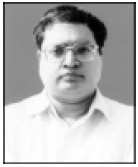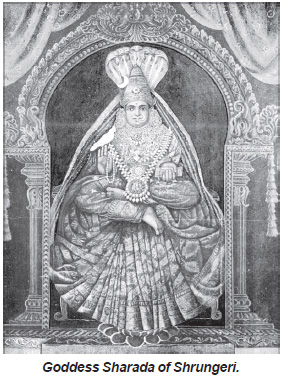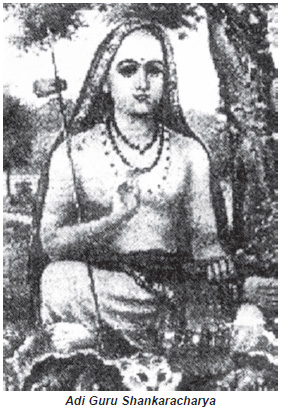The Goddess
Sharada of Shankaracharya
By Sanjay
Godbole
 Shankaracharya,
the first, was born in the year 788 A..D. at ‘Kaladi’
in Kerala. The day was the fifth day in Shukla
Paksha in the month of Vaishakh and the time was
noon as
per the Hindu Calendar. Shankaracharya hailed
from a family from Malabar. His family was a
Nambudripad Brahmin family, who led a simple
living style, but believed in high thinking and
had a tradition of being quite learned and
knowledgeable. Shankaracharya,
the first, was born in the year 788 A..D. at ‘Kaladi’
in Kerala. The day was the fifth day in Shukla
Paksha in the month of Vaishakh and the time was
noon as
per the Hindu Calendar. Shankaracharya hailed
from a family from Malabar. His family was a
Nambudripad Brahmin family, who led a simple
living style, but believed in high thinking and
had a tradition of being quite learned and
knowledgeable.
Shivguru
Nampudri and his wife Aryamba after many long
years of their married life did not have any
issues and being desirous to have one, they
started a penance for the blessings of Lord
Shiva. Lord Shiva was pleased with their penance
and came in their dreams and gave them a boon
that Aryamba would soon bear a son, who will be
brilliant, intelligent but who would be short
lived and ephemeral. The auspicious new born had
the following emblems on his body the wheel
symbol on his head -an eyelike symbol on his
forehead, a trident mark on his shoulders,
Looking all these, the astrologers declared
unanimously that the new born was nothing short
of an incarnation of Lord Shiva and they all
said that he would be called by’ Shankar’ as his
name. This Shankar (as he was called then) was
gifted with unparalleled brilliance and when he
was merely three, he started taking lessons,
through faculty” of speech, from his father.

Shankara became
proficient and adept in many sciences with
explanatory critical analysis of the same. As a
result of such a deep study, ascetic tendencies
were aroused in him. He had in his heart, an
intense desire for the well being of one and
all.
At the age of
five he entered the institution of his Guru at
Trichure. Within a span of three years, he
mastered the three disciplines of yoga. He also
attained the accomplishments of eight types of
divine powers. (These accomplishments arc called
Ashtasiddhis). These arc faculty of remote
listening, remote visualizing, power to enter
other bodies moving at the speed of light etc.
He went to his spiritual guide Swami Govind
Bhavatpad in central province, now known as
Madhya Pradesh and carried out the important and
vital mission of rejuvenating the ancient vedic
tradition of Aryan religion. Shankaracharya who
was well versed in all four vedas, had an
excellent command over Sanskrit and meters and
technique of poetry. He authored many hymns and
canticles praising Gods and Goddesses and many
poems and criticisms. He successfully-debated
with people who followed different schools of
thought and after winning over them, established
four centres of knowledge at the far-flung
corners in India. He thereby, so to say, sowed
the seeds, which would result into cultural and
spiritual integration. He organized the working
of the four centres, wliich he established, so
that each centre had one of the vedas as the
main theme of their functioning. Therefore each
of the four centres had its distinct identity as
to the system of working and propagation of its
central theme. Shankaracharya appointed the
following Principals i.e. Acharyas at different
centres, (a) Shrungeri -Surcshwaracharya (b)
Jyotirmath at Badrikcdar - Totakacharya (c)
Sharda Math at Dwarka -Hasmalkacharya (d)
Govardhan math at JagannathPuri -Hastamalakacharya.
In due course of time the fifth centre (Math) at
Kanchi was established. Shankaracharya, then
went to the city of Mahishmati which was
situated on the banks of river Narmada. There he
defeated Mandanmishra, an erudite in a debate
and made him his dcsciple. Ubhayabharati, the
wife of Mandanmishra, posed Shankaracharya, with
a questionnaire, asking for details, procedures,
rituals in the science of sex. Shankaracharya,
though he was a strict celibate since birth,
outwitted her by entering into the body of Amruk,
the ruler of Kashi (now known as Bcnaras or
Varanasi) and obtained the necessary details and
then giving satisfactory answers to the queries
raised by Ubhayabharati.
Shankaracharya
propogates that ‘Let the urighlcous become
riteous, let the wicked be benign let the
righteous attain tranquility and peace, let
those attaining peace emancipate themselves from
the worldly ties and those who have attained
emancipation, preach others to follow suite.
Shankaracharya, by dint of his intense and
glaring intellect, won over many erudites in
debates and guided them to the real path of
knowledge. Shankaracharya and his Acharyas
proved and established their intellectual
supremacy all over India. With a view to
preserve and protect the divine knowledge stored
in Vedas, he organized the ascetics in seven
forums. These groups are Ahwan, Mahanirvani,
Niranjani, Atul Anand, Agni and Bhairav.
Shankaracharya was an accomplished organizer and
a great philosopher.
Once it so
happened that Shankaracharya’s mentor, Guru
Govind, entered a cave and started his
meditation. The cave was near the banks of river
Narmada. The river was in full spate and the
water started gushing into the cave.
Shankaracharaya kept a big earthen pot at the
entrance of the cave and surprisingly, the flood
waters were emptied into the pot and could not
reach the cave.

When Govind yati
finished his meditation, he was surprised of
what Shankaracharaya achieved. He realized the
capabilities of Shankaracharaya and suggested to
him to write a criticism on the Brahmasutra.
Thereafter, Shankaracharaya, the erudite of the
tender age of twelve, started preaching the
Vcdanta philosophy on the Ghats of river Ganges
at Benaras. While at Benaras, the Lord Shankar (Kashi
Vishweshwara) Himself, presented before
Shankaracharya, in the disguise of a vile and
tested his wits and wisdom, through which
Shankaracharaya came out with flying colours.
Lord Vishwanatha
told Shankaracharaya to write an exhaustive
criticism on Brahma Sutra. The Lord also told
him to profess monism and uniqueness of Brahma’
(Universe). Shankaracharya chose to traverse to
‘Badari Khetra’ with an inherent desire to
draw-inspiration from the great anchorite Vyasa
and his blessings. On way to Badari Khetra, he
abrogated the prevalent tradition of human
sacrifice. He lived near ‘Vyasa Tirth’ and wrote
excellent criticisms on Brahama-Sutra,
Upnishadas and Bhagwatgceta. One fine morning,
Vyasa Maharshi, came to Shankaracharaya in the
form of a Brahmin and tested him and he
was satisfied with
Shankaracharaya’s wisdom; and blessed him. Even
though Shankaracharaya was destined to live for
only sixteen years, Vyasa gave a further lease
of sixteen more years to his life. After
Mandanmishra became a disciple of
Shankaracharaya, all the erudites, with their
scholarlincss and eruidition got fully geared up
for convening the philosophy of monism in the
whole of Northern India.
Shankaracharaya,
then travelled down to South along with his
disciples. There he canvassed monism at various
places like shaila, Gokarna. After the demise of
his mother, Shankaracharaya began his
pilgrimages. At the end of his entourage, he
went to Kashmir and established the Sarvadnya
Peetham and took charge of the same. All the
Kashmiri Brahmins got dazzled by the
intellectual acumen and wisdom of
Shankaracharaya. Shankaracharaya, then went to
Nepal. There he established a proposed standard
code of Vcdic rituals and observance thereof.
Since qualified and eligible priests capable of
performing correct, true and exact vedic rites
and rituals were not available Shankaracharaya
invited some Namputiri Brahmin priests from
Kerala for keeping the ancient Vcdic traditions
alive. His great work or mission encompassed the
following activities: a) Criticism of various
Suktas in an elucidative style, b) canvassing
his philosophy of monism; (c) Conquring debates
on all four sides and establishing centres (Mathas).
This gigantic mission he accomplished within a
short span of 31 years. He chose the pious land
of the Kedar Kshetra for his final departure
from his earthly incarnation and did leave this
world to have unisom with eternity on the 11th
day of the Shukla Paksh (first fortnight) in the
month of vaishakha at the age of 32 year as was
predicted earlier.
The research
scholars have unanimously arrived at the
conclusion that all those canticles are composed
by, Shankaracharaya only. These canticles are
‘Anand Lahari’ ‘Dakshina-moorty stotra’ ‘CharpatPanjari’,
Shivabhujang Prayat’ & the ‘Saundarya Lahri’ to
mention a few. For expounding the philosophy of
‘Vedanta’ Shankaracharaya authored several
volumes. Out of these, “Advaita Panchratna’ and
‘Vivekachudamani’ are particularly wellknown and
famous. The basic and fundamentally key concept
of the doctrine of Monism, propogated by Shri.
Shankaracharaya can be stated in a nutshell as
under i) The ultimate truth is Brahma 2) The
world we see is false and a mere illusion. 3)
Soul is nothing but Brahma only & 4) Soul and
Brahma are inseparable.
The ‘Bharatiya
Sanskriti Kosha’ (Indian Cultural Encyclopedia)
Vol No 1 Page 184 gives the following legend in
connection with Goddess Sharada. It reads as
follows:
“During the
previous birth, she was the wife of Lord
Brahmadeva and was known as ‘Saraswati’. She had
to take a new birth on account of a curse or
malediction by an ascetic called ‘Durvasa’ She,
during this birth (incarnation) was, in course
of time, married to Mandanmishra’ an erudite,
when she could have glimpses of Shankaracharaya
(who himself, was an incarnation of Lord Shiva).
She got emancipation from the ill effects of the
curse. She set out for her original place, where
she belonged to. Shankaracharaya, at that
juncture appealed to her that she should stay at
‘Shringeri’ only and permit her worshippers to
serve her. Saraswati acceded to
Shankaracharaya’s request and went to the River
Tunga and resorted to ‘Jal Samadhi’ (Jal means
water and Samadhi means transcending limits of
earthly identities). Her soul reached
‘Satyaloka’ but her mortal remains stayed there
only in the form of a rock. Shankaracharaya got
a wheel carved out on that rock and got a
sandlewood idol made, of Goddess Sharada and
installed it near that place. The Goddess, is
called ‘Sharadamba’. The Goddess is the
venerable deity at the Shringeri (Math). In due
course, Shri. Viddyaranyaa swami got a beautiful
temple erected and installed a golden image
(idol) of Sharadamba. The Shringeri Math is
situated on the banks of river Tungbhadra at
Koppa (Dist Kadur) in South India.
This is one of the sites in Karnataka worth
seeing. It has an expanse of 8 miles x 6 miles.
In the Dharma Kosha (encyclopedia of religion)
authored by Mr. James (Ref. Page 11-16) it is
stated that in order to convince the local
people more effectively, Shankaracharaya had to
master the local languages of that region.
Shri. C. G.
Karve has written an article in the issue of the
Marathi Magazine ‘Prasad’ of 1961. In that
article, Shri Karve says “The reason as to why
the centre (Matha) was established at Shringeri
is equally queer and strongly
supernatural. Shankaracharaya saw a cobra,
protecting a pregnant she-frog from the
torturing heat by-covering it with the help of
the shadow- of its fangs. This was very
exceptional. This incidence had a very deep
impact on him and it is exactly why he chose
this very spot for establishing his Math
(Monastery). Another reason why the Math was
given the name ‘Shringeri Math’ was that the
hillock on which the hermitage of the famous
ascetic ‘Rushyashrung’ existed is at a distance
of mere 9 miles from this spot.
The King Harihar
and his five brothers bestowed upon the
authorities of this Math the right to collect
the revenue accrued from the nine villages,
nearby. There have been 35 Acharayas (Head) of
this Matha hereinsofar (Rcf. Ayyer Pp 118) How,
the King of Vijaynagar made a permanent
provision of assured income for the Math, has
already been detailed hereinabove. This empire
was founded by king Harihar the first in Shaka
1258. The city of ‘Kishkindha’ was the capital
city of this empire. Sayan and Madhav were both
ministers in this Kingdom. Both of them resorted
to spiritualism and rose to fame by the new
names such as Sayannacharya and Vidyaranya
Swami. They have authored 150 volumes in
Sanskrit and the Devyaparadha Stotra (Canticle)
is very famous. Sayannacharya has written many
criticisms or interpretationary expoundings of
many famous literary works.
Apart from and
besides the idol of Goddess Sharada, the idols
of Venugopal and Shriniwasa in other temples are
worth seeing and attract attention of all. A
figure of Nandi carved out on a pearl (Vehicle
of Lord Shiva) is exhibited here and is
considered to be one of the finest sculptures.
The temple
of
Navagrahas here (NinePlannets) is also worth
seeing. This temple has twelve sculpted pillars.
On top of each pillar there is a figure of Lion
and a person mounting on it. In the Jaws of the
Lions, bright and sparkling spheres, made out of
superior quality rock are so placed so as to
rotate within the jaws without slipping out from
the jaws. These 12 sculpted pillars symbolize
the 12 signs of zodiac and according to or in
unison with the time, the rays of the Sun
falling on the pillars get reflected from the
spheres. The symbolic figures of planetary
bodies such as Saturn, Jupitor, Venus, Moon etc
are fitted and the combined effect of all this
gives one a fairly accurate idea as to how solar
family as a whole moves around the Sun. This
setup is really intelligently devised (Ref:
Ayyer PP. 360-362)
In
the Devikosha (encyclopedia of Goddesses)
on page no. 339 volume -1st, the following
details are given. “There arc several
copperplates and inscriptions in the ‘Matha’.
They all indicate the Peshwa rulers of Pune held
the Acharyas of this Matha in high esteem and
the Acharyas were given the highest honours by
giving them the first prestigious position in
worshipping the deities. Not only that but the
Muslim rulers too, had the feeling of reverence
in their minds towards the Heads of the Math.
The Nawab of Mysore, HyderAli Khan presented the
then Head of the Matha, elephants and horses and
felicitated him and paid him respects. He (HyderAli
Khan) sanctioned a sum often thousand rupees
towards the expenses to be incurred for taking
the Acharya of the Matha from Shringeri to the
capital (Mysore). The Tipu Sultan, the son of
HyderAli Khan continued carry cany the
inheritance of his father with the same ferver
and faith. Once a gang of robbers, plundered the
Matha and in a letter written by him to the
authorities of the Matha by way of consolations,
he wrote those who have committed this heinous
act with a sense of pleasure, will weep when
they repay for their actions.
Tipu Sultan was
a great admirer of Shringeri Math, besides being
a patron to it. He often requested the religious
Heads to pray to God for prevalence of peaceful
conditions in the state, general welfare of the
public and for bcingvictorious in any ensuring
battles. Once he even went to the extent of
asking the Brahmins to perform ‘Sahastra Chandi
sacrifice’ and fed them with sumptuous meals for
40 days continuously and made liberal offerings
to them -This is mentioned in the chronicals -
(Ref.: Report of the Archaeological Department -
-Govt, of Mysore -year 1916 PP 74/75).
*(The author is a noted
Archeologist, based in Pune)
Source: Kashmir
Sentinel
| 








 Shankaracharya
Shankaracharya






No one has commented yet. Be the first!